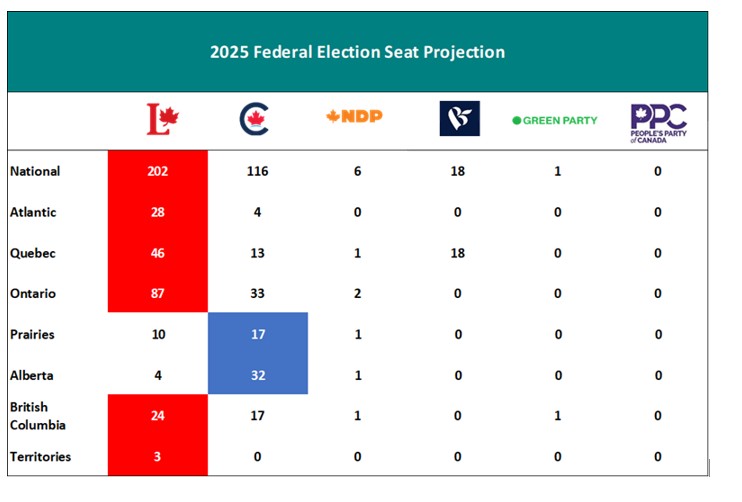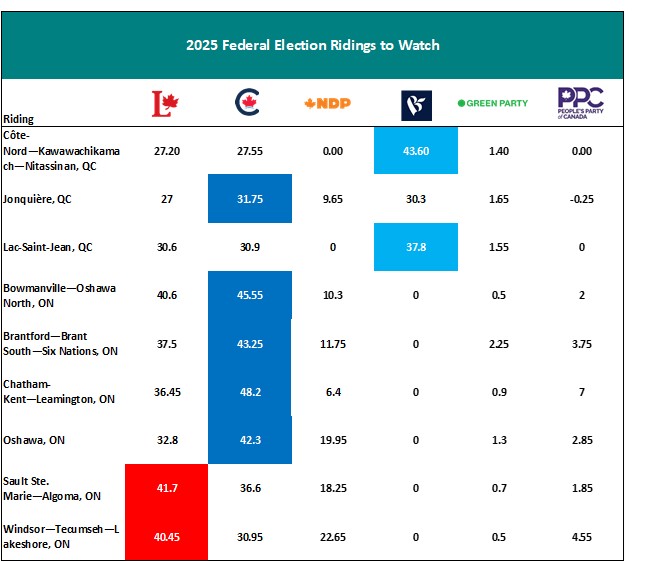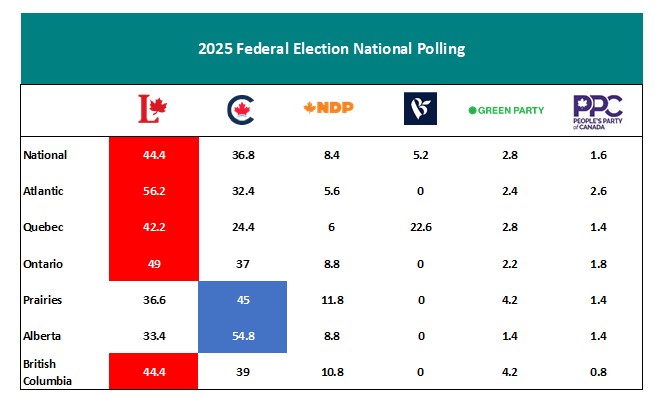By: Brian Klunder, Senior Counsel
We are nearing the halfway point of this election, and the Liberals are maintaining a lead; however, questions persist about the solidity of this lead and whether Pierre Poilievre and the Conservatives can still win.
Last week’s tariff announcement from the Trump Administration provided another example of how the President is defining the ballot question as voters seek to decide who is best able to manage Canada’s economy through turbulent waters and represent our government in discussions with the U.S. Continued market turmoil will mean tariffs and their impact on this election will matter.
Given that the ballot questions are critically impacted by the effects of tariffs on the Canadian economy, this week, I am examining ridings directly affected by the tariffs on steel, aluminum, and automobiles. I recognize that all ridings are affected, but those outlined in this analysis have specific impacts due to these targeted tariffs, which could cause regional impacts more significant than those of the province or country as a whole.
Seat Projection (majority requires 172 seats)
In terms of my seat projection, we are seeing the Liberals leading and expected to win a substantial majority with 202 seats and the Conservatives at 116 seats. All other parties are considerably further back, with the NDP at six seats, the Bloc at 18 seats, and the Green Party winning one.
Mark Carney and the Liberals are showing strength in Ontario, Quebec, and in the Atlantic, a trend consistent across all pollsters. Some are showing high support for the Liberals in Manitoba, Saskatchewan and Alberta. This would go against the grain of what we have seen in recent history – especially in Alberta and Saskatchewan – and I would expect the number to be closer to historical results come Election Day.
B.C. remains close, with the Liberals maintaining a slight lead. The NDP would win, in my projection, only one seat in B.C., which would be a significant hit to their ability to maintain party status.

Ridings to Watch
Below, I examine projections for key ridings in Ontario and Quebec that are directly affected by tariffs on steel, aluminum, and automobiles. I have chosen ridings where I see the potential for close races. These races will play a significant role in determining the type of government we have after April 28.
Outlined below are the ridings we are watching with the tariff impact in mind.
Quebec
Côte-Nord—Kawawachikamach—Nitassinan – Home to significant aluminum facilities in both Baie-Comeau (Brian Mulroney’s hometown) and Sept-Îles. Currently, we are seeing the Bloc hold onto this riding, as the Conservatives and Liberals remain close in the high 20% range.
Jonqiuère – Jonqiuère is at the centre of the aluminum sector in Quebec. This is currently a three-way race, with the Conservatives edging out the incumbent Bloc slightly, but both the Liberals and the Bloc are within striking distance of the win.
Lac-Saint-Jean – Like Jonqiuère, Lucien Bouchard’s old riding is another riding deeply impacted by aluminum tariffs. The Bloc is currently leading, but this could change if Bloc support continues to decline.
Ontario
Bowmanville—Oshawa North – Oshawa is home to GM and any impacts on the North American auto sector will be deeply felt in Bowmanville—Oshawa North. Pierre Poilievre held a massive rally last week in the area as he works to secure Oshawa area ridings. Currently, the race is close, as the Liberals benefit from the NDP’s collapse.
Brantford—Brant South—Six Nations – Full disclosure this is the riding in which I was raised. Due to its proximity to steel plants in Hamilton and Nanticoke, auto manufacturers in Cambridge and Woodstock, and its own significant manufacturing facilities – the riding will be heavily impacted by tariffs. The Conservatives appear to be in a position to hold the seat, but, with a lead of less than 6% of the vote, the race is far closer than anyone predicted.
Chatham-Kent—Leamington – Chatham-Kent—Leamington is not a riding on anyone’s radar, but the auto sector has a significant impact on any riding this deep into Southwestern Ontario. The Conservatives are maintaining a healthy lead.
Oshawa – Like Bowmanville—Oshawa North, the riding of Oshawa is heavily impacted by the health of the auto sector. Anything that hurts the industry hurts this riding. We are seeing the Conservatives maintain a 10-point advantage, showing their ability to keep seats impacted by tariffs.
Sault Ste. Marie—Algoma – Sault Ste Marie’s largest employer is Algoma Steel, and as a border city, it is also heavily influenced by the U.S. The Sault has been a close riding in the past and we would expect that it will also be very close on April 28 – with both the Liberals and Conservatives able to win.
Windsor—Tecumseh—Lakeshore – This seat was a long-time NDP stronghold under former M.P. Joe Comartin. Since 2019, it has been held by Liberal Irek Kusmierczyk. The Liberals are winning and looking to strengthen its foothold in Canada’ auto capital (even as it seeks to take Windsor West from the NDP.)

National Polling Average (%)
Polls range from near ties to substantial leads for the Liberals. This makes precise projections difficult, but my poll averaging tends to smooth out the extremes on either end.
I believe a polling average of over 33% for the Liberal Party in Alberta is high and would be challenging to maintain through Election Day. The same is true in Quebec, where the Liberals currently have, on average, over 42% of the vote and significant leads over both the Conservatives and the Bloc. I expect the next week to begin showing a tightening of the race as these numbers shift.

What It Means
After two weeks, predictions that this will become a Liberal vs. Conservative race are accurate. The tariff battle, accompanied by turbulent market conditions, will continue to dominate the discussion among Leaders. Week 3 is always challenging, and each party looks to finalize platforms and prepare for debates on April 16 and 17. While Mark Carney and his team should be delighted with their current standing after two weeks, this race is far from over, and Pierre Poilievre can still win.
Methodology – The TSA Seat projection is calculated based on publicly released polls over the previous week. Each riding result is based on the results of the 2019 and 2021 elections and transposed to the new seat boundaries. Thanks to the work Phillipe Fournier has done at 338Canada to transpose votes for both 2019 and 2021. Riding results are compared to regional results in 2019 and 2021 to calculate a projected result for each riding.

